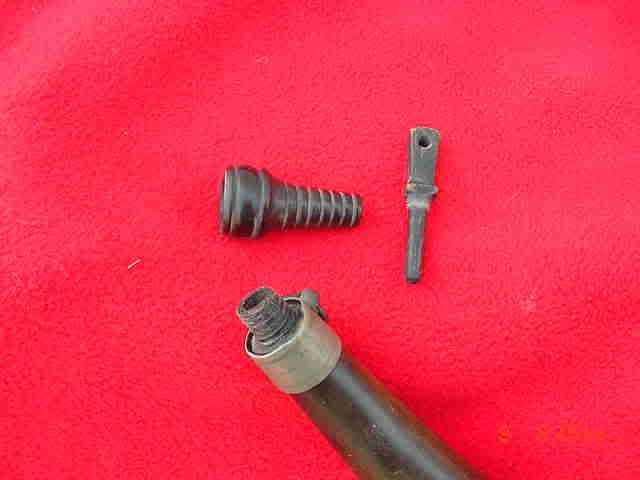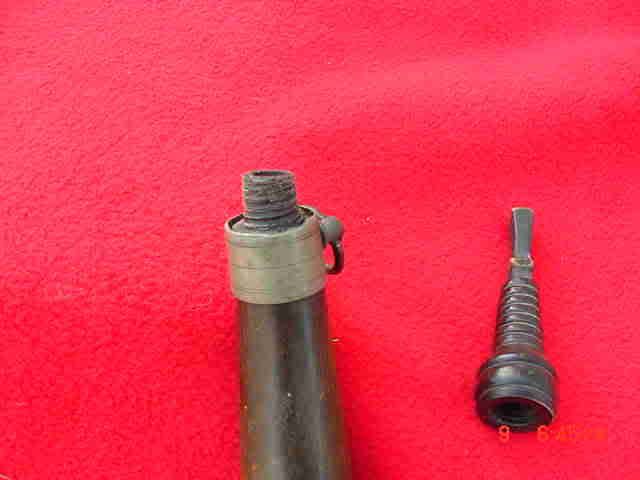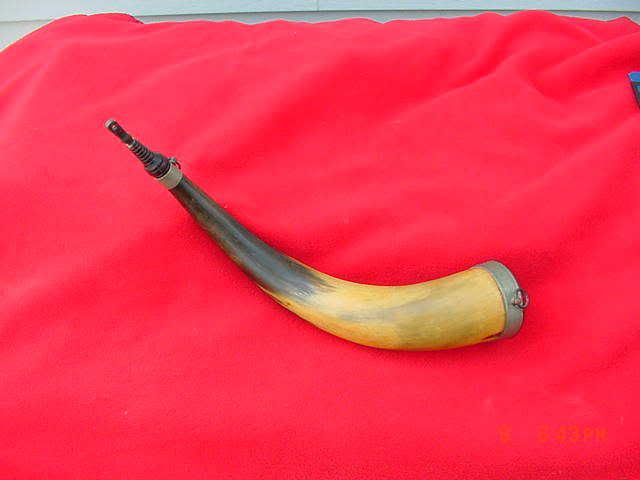For the horners out there who make screw tip horns, what size or sizes of taps and dies do you most commonly use? Do you use wood tap and dies or maybe pipe? Gonna try one and not sure what size and kind of tap and die set to buy.
-
This community needs YOUR help today. We rely 100% on Supporting Memberships to fund our efforts. With the ever increasing fees of everything, we need help. We need more Supporting Members, today. Please invest back into this community. I will ship a few decals too in addition to all the account perks you get.

Sign up here: https://www.muzzleloadingforum.com/account/upgrades -
Friends, our 2nd Amendment rights are always under attack and the NRA has been a constant for decades in helping fight that fight.
We have partnered with the NRA to offer you a discount on membership and Muzzleloading Forum gets a small percentage too of each membership, so you are supporting both the NRA and us.
Use this link to sign up please; https://membership.nra.org/recruiters/join/XR045103
You are using an out of date browser. It may not display this or other websites correctly.
You should upgrade or use an alternative browser.
You should upgrade or use an alternative browser.
Screw tip...
- Thread starter riverrat43
- Start date

Help Support Muzzleloading Forum:
This site may earn a commission from merchant affiliate
links, including eBay, Amazon, and others.
riverrat43 said:For the horners out there who make screw tip horns, what size or sizes of taps and dies do you most commonly use? Do you use wood tap and dies or maybe pipe? Gonna try one and not sure what size and kind of tap and die set to buy.
RR,
You can use regular machinisht's taps and dies. The size depends on and should be appropriate to the size of the horn you are working on. A 5/8" size would be good for most horns. Just make sure you get a coarse thread tap and die set like 5/8-11. Remember to go slow when threading and clear the tap and die often to prevent tearing the threads in the horn or antler.
Randy Hedden
Thanks Randy..that helps.
Listen to Harddog. I have tried 5/8 and 3/4 and 3/4 is too big, stick with the 5/8. Use course threads, even then the horn is hard to cut without stripping the threads. In other words go slow and careful- just cut a little bit, back out the tool and clean it up. It is easy to break/strip the threads.
Hey Riverrat.
I asked about the same question on here a couple weeks ago. I decided to try the wood thread setup by Hartville tool.
I got to thinking that a threaded plug in the plug would be a lot more weathertight. If you decide to go that way, be warned: mine was backordered for the next month. :cursing:
H
I asked about the same question on here a couple weeks ago. I decided to try the wood thread setup by Hartville tool.
I got to thinking that a threaded plug in the plug would be a lot more weathertight. If you decide to go that way, be warned: mine was backordered for the next month. :cursing:
H
riverrat43,
I've had good luck making screw tip horns using the kits from Woodcraft:[url] http://www.woodcraft.com/family.aspx?familyid=792[/url]
They have several sizes and all work great on horn as well as wood tips.
Thanks,
Ron
I've had good luck making screw tip horns using the kits from Woodcraft:[url] http://www.woodcraft.com/family.aspx?familyid=792[/url]
They have several sizes and all work great on horn as well as wood tips.
Thanks,
Ron
Last edited by a moderator:
Guest
ricktwin said:riverrat43,
I've had good luck making screw tip horns using the kits from Woodcraft:[url] http://www.woodcraft.com/family.aspx?familyid=792[/url]
They have several sizes and all work great on horn as well as wood tips.
Those look great. The smallest one I see is 1/2 inch. Does that mean the hole in the end of the horn is going to be 1/2 inch in diameter? :shocked2:
Woodthreading Kit, 1/2" x 8 TPI
Last edited by a moderator:
paulvallandigham
Passed On
- Joined
- Jan 9, 2006
- Messages
- 17,538
- Reaction score
- 80
I think you are expecting to use this kind of plug in the pouring end of the horn, instead of the baseplug. These large sizetaps are for making plugs in the Base Plug, so you can load the horn quickly and conveniently. The pouring hole is rarely more than 1/4 inch in diameter. I have seen screw pegs used to stop the horn, but they are done with coarse American metal screw taps and dies. I prefer to see a beveled peg use, and use a tapered reamer made for violin pegs to prepare the mouth of the horn. The bevel allows the peg to be given a twist to lock it in place, and as the wood in your stopper compresses with use, the bevel just makes a new point of contact on the stopper. You can buy a tapered reamer at most harware stores.
Guest
dvlmstr said:Dale
Here are pictures of an original screw tip horn.
The stub coming out of the horn would have a 1/2" male thread and the tip would be 1/2" female.
The hole into the horn cavity is about 1/4".
Hope this helps.
Ah ha! Got it.
Great horn. How old is it?
Thanks for all the replies. Lot's of good info and suggestions. Sometime in the near future I'll probably try my hand at this screw tip idea. I'm wondering though, why would you put a hole and a stopper in the part of the tip that screws on and off the spout of the horn?(the horn in the picture) I'm thinking that the purpose of the screwed on tip would be to keep the powder in the horn and would be unscrewed when you needed to pour. Done this way it would also do away with the problem of losing plugs and could possibly serve as a ready made measure.
Dale
It is a Lancaster style horn, I would guess it was made about 1820 or maybe a little later.
Did you notice it is also a left handed horn?
Riverrat
The screw tip idea was to make filling the horn easier. Using a plug in the tip is much easier to handle in the field. Imagine trying to unscrew the tip for each shot and how you would be fumbling around.
Hope this helps.
Regards, Dave
It is a Lancaster style horn, I would guess it was made about 1820 or maybe a little later.
Did you notice it is also a left handed horn?
Riverrat
The screw tip idea was to make filling the horn easier. Using a plug in the tip is much easier to handle in the field. Imagine trying to unscrew the tip for each shot and how you would be fumbling around.
Hope this helps.
Regards, Dave
dvlmstr:that was my opinion about screw tips and I think the Henry Kaufman book said the idea was the tip could be removed, exposing a larger hole for more easy filling. That's probably true but when I mentioned this to Roland Cadle he seemed to down play that aspect as a lot of horns have staples in the base plug and no screw tip- you just had to spend a lot of time filling the horn. Roland was pretty adament that the whole idea behind a screw tip was that a decorative tip could be turned out on a lathe very quickly and fitted to the horn. Today, if we try to make this type horn it is a lot of work because we have to buy dies, taps, special jigs, etc. The horners of the time had their shops set up where they could produce these horns very quickly- or so I have been told.
Muzzleloader magazine had an issue 6 months to a year ago on screw tips- (Gunsmith column) a really good article.
Muzzleloader magazine had an issue 6 months to a year ago on screw tips- (Gunsmith column) a really good article.
Crockett
I wouldn't belittle Roland by any means but I think the vast majority of horns were not made by horners, you see all skill levels exhibited. You say Roland said that a lot of horns have staples in the base plug and no screw tip- you just had to spend a lot of time filling the horn. I agree, you note though "you just had to spend a lot of time filling the horn", it didn't take the professionals long to figure out that they could make a horn that was much easier to fill, and easier and faster to finish the decorative elements using a lathe. The finished product would be more desireable to the customer.
If you look at earlier horns the hole for the plug is generally much larger than most of what we use today. This was pointed out to me by a couple of friends who study period artifacts, George Carroll and Jon Ansbaugh several years ago. They felt that the large hole made filling the horn easy but may have made it hard to measure out a charge without spillage. The screw tip would cure both problems.
I certainly agree that the non-professional and even semi-professional probably did not have all special taps, dies, and special jigs the the true professionals did that made their work so nice.
But this is just my opinion.
Regards, Dave
I wouldn't belittle Roland by any means but I think the vast majority of horns were not made by horners, you see all skill levels exhibited. You say Roland said that a lot of horns have staples in the base plug and no screw tip- you just had to spend a lot of time filling the horn. I agree, you note though "you just had to spend a lot of time filling the horn", it didn't take the professionals long to figure out that they could make a horn that was much easier to fill, and easier and faster to finish the decorative elements using a lathe. The finished product would be more desireable to the customer.
If you look at earlier horns the hole for the plug is generally much larger than most of what we use today. This was pointed out to me by a couple of friends who study period artifacts, George Carroll and Jon Ansbaugh several years ago. They felt that the large hole made filling the horn easy but may have made it hard to measure out a charge without spillage. The screw tip would cure both problems.
I certainly agree that the non-professional and even semi-professional probably did not have all special taps, dies, and special jigs the the true professionals did that made their work so nice.
But this is just my opinion.
Regards, Dave
Similar threads
- Replies
- 40
- Views
- 2K
Latest posts
-
FOR SALE Custom made 36cal full stock percussion- squirrel rifle
- Latest: Johnny Too-Tall
-
-
-
-
-
-
-
-






